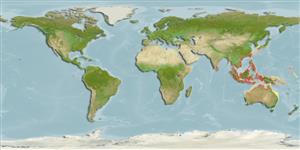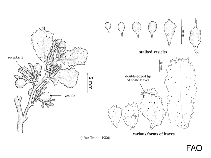Sargassum gracillimum Reinbold
Gracile sargassum| Native range | All suitable habitat | Point map | Year 2050 |

|
| This map was computer-generated and has not yet been reviewed. |
| Sargassum gracillimum AquaMaps Data sources: GBIF OBIS |
Google image | No image available for this species;
drawing shows typical species in Sargassaceae.
Classification / Names Populärnamn | synonymer | CoL | ITIS | WoRMS
Phaeophyceae | Fucales | Sargassaceae
Environment: milieu / climate zone / djupintervall / distribution range Ekologi
. Tropical
Distribution Länder | FAO områden | Ekosystem | Förekomster | Utplanteringar
Indo-West Pacific.
Length at first maturity / Size / Weight / Age
Könsmognad: Lm ? range ? - ? cm
Short description Morfologi
Life cycle and mating behavior Könsmognad | Reproduktion | Lek | Eggs | Fecundity | Larvae
Main reference
referenser | Koordinator | Medarbetare
Guiry, M.D. and G.M. Guiry 2009 AlgaeBase. World-wide electronic publication, National University of Ireland, Galway. http://www.algaebase.org; searched on 14 April 2009. (Ref. 80701)
IUCN Red List Status
(Ref. 130435: Version 2025-1)
CITES status (Ref. 108899)
CMS (Ref. 116361)
Threat to humans
Human uses
Fiskeri: kommersiell
| FishSource |
Verktyg
Ytterligare information
Födosammansättning
Födointag
Predatorer
Max. ages / sizes
Length-weight rel.
Length-length rel.
Length-frequencies
Mass conversion
Abundans
Könsmognad
Fecundity
Lek
Eggs
Egg development
Larvae
Internet-källor
BHL | BOLD Systems | CISTI | DiscoverLife | FAO(Publication : search) | Fishipedia | GenBank (genome, nucleotide) | GloBI | Gomexsi | Google Books | Google Scholar | Google | PubMed | AlgaeBase | Tree of Life | Wikipedia (Go, sök) | Zoological Record



